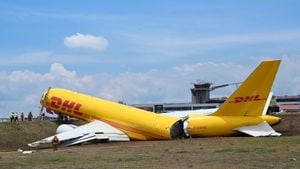Two astronauts stranded aboard the International Space Station (ISS) may seem like something out of a sci-fi movie, but for NASA's Barry Wilmore and Sunita Williams, it's their current predicament. Originally intended as a brief eight-day mission on Boeing's Starliner, their stay has dramatically extended due to troubling malfunctions with the spacecraft.
The duo was meant to make the first crewed test of the Starliner capsule, but misfortunes have emerged. The Starliner experienced serious issues, including helium leaks and faulty thrusters, particularly notable as it approached the ISS.
NASA officials are expected to determine soon whether to allow the Starliner to carry the astronauts back to Earth, adding more uncertainty to their situation. A possibility looms where the astronauts could remain aboard the ISS for six additional months if the spacecraft is deemed unsafe for their return.
Waiting under norm, even if frustrating, has its share of pressures, but for astronauts, it can be particularly excruciated. Especially when anxieties swirl about whether they'll ever return home safely, this waiting game morphs from merely frustrating to agonizing.
Scientific insights shed some light on how time perception alters during uncertain circumstances. During downtime, the brain becomes overly vigilant about the passing of seconds, leading to feelings as if time is dragging, as if every clock tick is being painfully monitored.
All this time on their hands may lead to increased stress. With social interaction limited and physical activities absent, astronauts might find boredom and anxiety compounding their discomfort.
Health concerns also pile on top of their existing challenges. NASA's medical teams are fully aware of these risks, including health issues stemming from prolonged space travel, such as Spaceflight Associated Neuro-ocular Syndrome (SANS) affecting Sunita Williams' vision.
The physical impacts of extended spaceflight aren't just limited to eyesight; muscle atrophy and weakened bones also come with the territory. With each extra hour spent aboard, worries about the astronauts' well-being intensify.
Issues with the Starliner’s design pose serious threats to both NASA and Boeing’s reputation. The capsule, originally scheduled to return the astronauts shortly after their arrival, has now increased scrutiny of Boeing's reliability.
The poor timing of these issues strikes particularly hard for Boeing, which has faced setbacks and controversies surrounding its commercial jets. The saga of the Starliner, marked by failures, adds to mounting pressure on the aerospace giant.
NASA remains committed to the Starliners’ credibility and the hope its crew can still return home via the same vessel. Yet, if the spacecraft is deemed unsafe, discussion about alternative returning options is well underway.
This brings SpaceX back to the conversation, highlighting its past successes with its Crew Dragon spacecraft. NASA is contemplating whether it could send another mission to facilitate the astronauts' return, which emphasizes how contingency planning is becoming ever more complex.
Following extensive tests at White Sands Testing Facility, initial indications seem to suggest some propulsion issues stem from undersized seals within the spacecraft. These failures have proven problematic for performance expectations, particularly during maneuvers required for safe docking and undocking from the ISS.
With the Crew Dragon capsule’s reliability, returning via SpaceX would mark a significant point of embarrassment for Boeing, whose declining fortunes hang over the impressive legacy it hopes to leave behind. The fragility of humanity's struggle to conquer space bubbles to the surface amid this crisis.
Even though time is seemingly crawling for astronauts aboard the ISS, they must remain vigilant and ready for any sudden changes. Such unexpected measures will serve as reminders of the unpredictable, rocky path humanity must navigate as it explores outer space.
The protagonists of this real-life thriller, astronauts Wilmore and Williams, portray remarkable resilience amid uncertainties. Their experience sheds light on the psychological and physical toll of extended space missions, amplifying the importance of well-engineered spacecraft capable of safely ferrying crew back and forth from the ISS.
The timeline to resolve these issues and ascertain if the spacecraft can carry them home safely is looming. All eyes are now on NASA and Boeing as they strive to untangle this web of technical difficulties and restore confidence — not just for their astronauts but for future missions.



